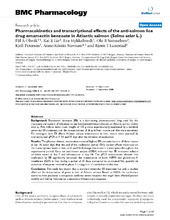| dc.contributor.author | Olsvik, Pål Asgeir | |
| dc.contributor.author | Lie, Kai Kristoffer | |
| dc.contributor.author | Mykkeltvedt, Eva | |
| dc.contributor.author | Samuelsen, Ole Bent | |
| dc.contributor.author | Petersen, Kjell | |
| dc.contributor.author | Stavrum, Anne-Kristin | |
| dc.contributor.author | Lunestad, Bjørn Tore | |
| dc.date.accessioned | 2020-02-17T07:58:00Z | |
| dc.date.available | 2020-02-17T07:58:00Z | |
| dc.date.issued | 2008-09-11 | |
| dc.Published | Olsvik PA, Lie Kk, Mykkeltvedt E, Samuelsen OB, Petersen K, Stavrum A, Lunestad BT. Pharmacokinetics and transcriptional effects of the anti-salmon lice drug emamectin benzoate in Atlantic salmon (Salmo salar L.). BMC Pharmacology. 2008;8:16. | eng |
| dc.identifier.issn | 1471-2210 | en_US |
| dc.identifier.uri | https://hdl.handle.net/1956/21417 | |
| dc.description.abstract | Background: Emamectin benzoate (EB) is a dominating pharmaceutical drug used for the treatment and control of infections by sea lice (Lepeophtheirus salmonis) on Atlantic salmon (Salmo salar L). Fish with an initial mean weight of 132 g were experimentally medicated by a standard seven-day EB treatment, and the concentrations of drug in liver, muscle and skin were examined. To investigate how EB affects Atlantic salmon transcription in liver, tissues were assessed by microarray and qPCR at 7, 14 and 35 days after the initiation of medication. Results: The pharmacokinetic examination revealed highest EB concentrations in all three tissues at day 14, seven days after the end of the medication period. Only modest effects were seen on the transcriptional levels in liver, with small fold-change alterations in transcription throughout the experimental period. Gene set enrichment analysis (GSEA) indicated that EB treatment induced oxidative stress at day 7 and inflammation at day 14. The qPCR examinations showed that medication by EB significantly increased the transcription of both HSP70 and glutathione-S-transferase (GST) in liver during a period of 35 days, compared to un-treated fish, possibly via activation of enzymes involved in phase II conjugation of metabolism in the liver. Conclusion: This study has shown that a standard seven-day EB treatment has only a modest effect on the transcription of genes in liver of Atlantic salmon. Based on GSEA, the medication seems to have produced a temporary oxidative stress response that might have affected protein stability and folding, followed by a secondary inflammatory response. | en_US |
| dc.language.iso | eng | eng |
| dc.publisher | BioMed Central | en_US |
| dc.rights | Attribution CC BY 2.0 | eng |
| dc.rights.uri | http://creativecommons.org/licenses/by/2.0/ | eng |
| dc.subject | Gene Ontology | eng |
| dc.subject | Atlantic salmon | eng |
| dc.subject | Ivermectin | eng |
| dc.subject | Protein Disulfide Isomerase | eng |
| dc.subject | Salmo Salar | eng |
| dc.title | Pharmacokinetics and transcriptional effects of the anti-salmon lice drug emamectin benzoate in Atlantic salmon (Salmo salar L.) | en_US |
| dc.type | Peer reviewed | |
| dc.type | Journal article | |
| dc.date.updated | 2019-10-17T12:32:09Z | |
| dc.description.version | publishedVersion | en_US |
| dc.rights.holder | Copyright 2008 Olsvik et al | en_US |
| dc.identifier.doi | https://doi.org/10.1186/1471-2210-8-16 | |
| dc.identifier.cristin | 1738038 | |
| dc.source.journal | BMC Pharmacology | |

